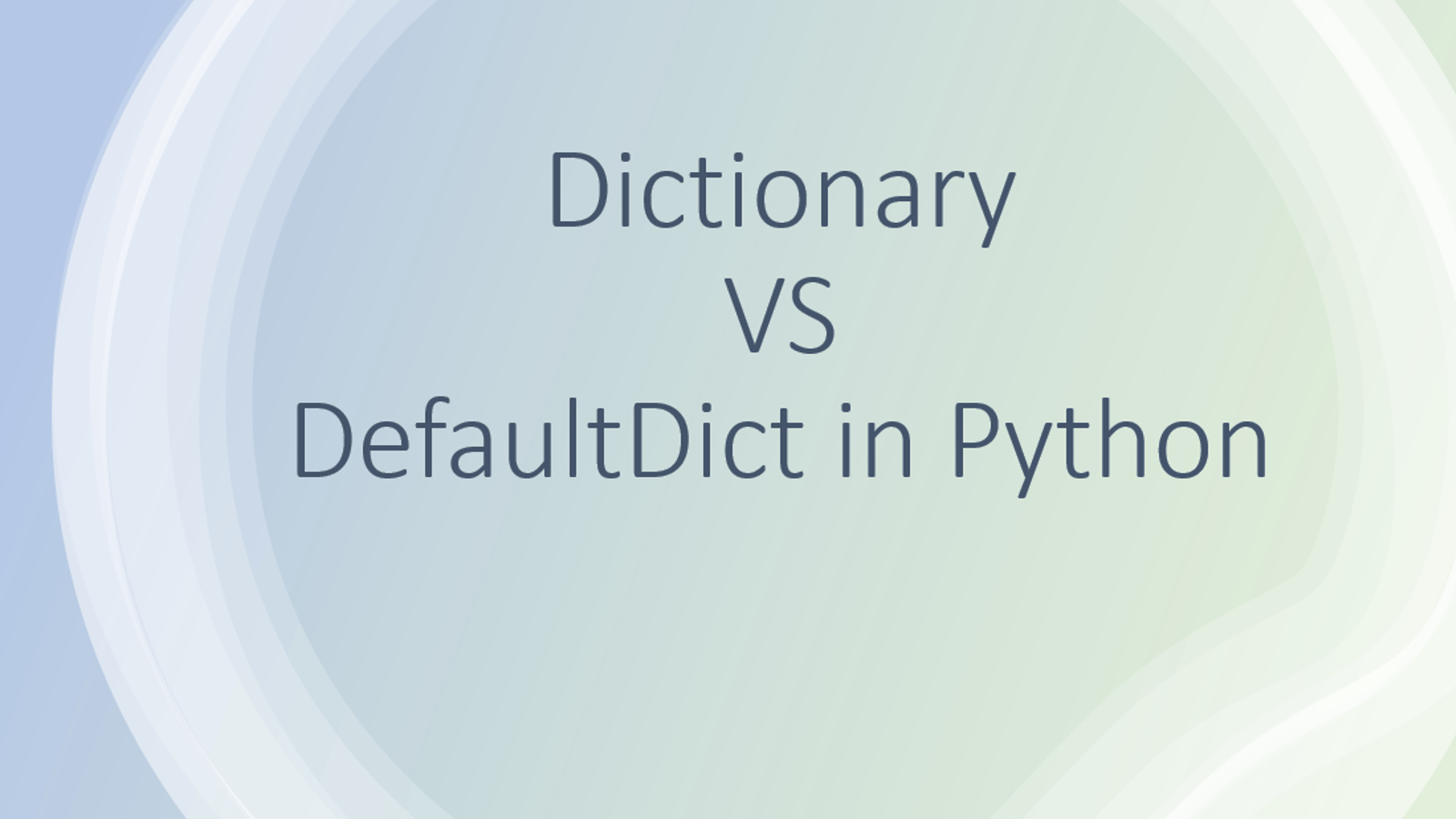In the world of Python programming, dictionary management can often become complex and verbose. Enter defaultdict, a powerful tool from the collections module that revolutionizes how we handle dictionaries with missing keys. This comprehensive guide will explore everything you need to know about defaultdict, from its basic usage to advanced techniques that can simplify your code and improve performance.
What is DefaultDict?
A defaultdict is a subclass of Python's built-in dict class that provides a clever solution to handling missing keys. Unlike standard dictionaries that raise a KeyError when accessing a non-existent key, defaultdict automatically creates a default value for any new key.
Basic Syntax and Import
from collections import defaultdict
# Basic defaultdict creation
my_dict = defaultdict(int) # Default value will be 0
my_other_dict = defaultdict(list) # Default value will be an empty list
This example shows how to import and create defaultdict with different default value types. The int() factory creates 0, while list() creates an empty list for any new key.
Why Use DefaultDict?
Solving Common Dictionary Challenges
Consider a typical scenario of counting occurrences:
Traditional Dictionary Approach
# Standard dictionary method
word_count = {}
text = "hello world hello python world"
for word in text.split():
if word not in word_count:
word_count[word] = 0
word_count[word] += 1
This approach requires explicitly checking and initializing each new key before incrementing.
DefaultDict Solution
# Simplified with defaultdict
word_count = defaultdict(int)
for word in text.split():
word_count[word] += 1
The defaultdict version is more concise, readable, and eliminates repetitive initialization code.
Key Features and Use Cases
1. Automatic Default Value Creation
defaultdict accepts a factory function that generates a default value for any new key:
# Different factory functions
int_dict = defaultdict(int) # Default: 0
list_dict = defaultdict(list) # Default: []
set_dict = defaultdict(set) # Default: set()
zero_dict = defaultdict(lambda: 0) # Custom lambda function
Each example above shows a different way to create default values: using built-in types or a custom lambda function.
2. Grouping and Aggregation
This snippet below demonstrates how defaultdict can easily group items based on a key (in this case, name length).
# Grouping items efficiently
names = ['Alice', 'Bob', 'Charlie', 'David', 'Eve']
name_length_group = defaultdict(list)
for name in names:
name_length_group[len(name)].append(name)
# Result: {5: ['Alice', 'David'], 3: ['Bob', 'Eve'], 7: ['Charlie']}
3. Nested Dictionaries
The code below shows how defaultdict can simplify creation of nested dictionary structures without manual initialization.
# Creating nested structures easily
nested_dict = defaultdict(dict)
nested_dict['user']['name'] = 'John'
nested_dict['user']['age'] = 30
Advanced DefaultDict Techniques
Custom Factory Functions
You can use any callable that returns a default value:
def custom_default():
return {'count': 0, 'timestamp': None}
advanced_dict = defaultdict(custom_default)
advanced_dict['user1']['count'] = 5
The example above demonstrates creating a custom factory function that returns a more complex default value.
Nested DefaultDict
# Multi-level nested defaultdict
multi_level = defaultdict(lambda: defaultdict(list))
multi_level['category']['fruits'].append('apple')
The code snippet above creates a nested defaultdict with multiple levels, allowing easy deep dictionary creation.
Performance Considerations
Memory and Speed
defaultdicthas minimal overhead compared to standard dictionaries- Slightly faster than manual key checking
- Reduces boilerplate code
Benchmark Example
This is a practical example of using defaultdict for log analysis, tracking error counts and details.
import timeit
from collections import defaultdict
def standard_dict_method():
word_count = {}
text = "hello world hello python world"
for word in text.split():
if word not in word_count:
word_count[word] = 0
word_count[word] += 1
def defaultdict_method():
word_count = defaultdict(int)
text = "hello world hello python world"
for word in text.split():
word_count[word] += 1
# Timing comparison
print(timeit.timeit(standard_dict_method, number=10000))
print(timeit.timeit(defaultdict_method, number=10000))
Real-World Application Scenarios
1. Log Analysis
from collections import defaultdict
def analyze_logs(log_entries):
error_count = defaultdict(int)
error_details = defaultdict(list)
for entry in log_entries:
if entry.startswith('ERROR'):
error_type = entry.split()[1]
error_count[error_type] += 1
error_details[error_type].append(entry)
return error_count, error_details
This example implements a memoized fibonacci function using defaultdict to cache and optimize recursive calculations.
2. Caching and Memoization
def memoized_fibonacci():
cache = defaultdict(int)
def fib(n):
if n < 2:
return n
if n not in cache:
cache[n] = fib(n-1) + fib(n-2)
return cache[n]
return fib
Shows how to use type hinting with defaultdict to specify key and value types.
Common Pitfalls and Best Practices
Best Practices
- Use when you need automatic default values
- Choose appropriate factory functions
- Be cautious with mutable default values
Potential Limitations
- Slightly higher memory usage for complex factory functions
- Can mask programming errors if used incorrectly
Type Hinting with DefaultDict
from collections import defaultdict
from typing import DefaultDict, List
def typed_defaultdict() -> DefaultDict[str, List[int]]:
return defaultdict(list)
Alternatives to Consider
dict.setdefault()method- Manual dictionary initialization
- Custom dictionary subclassing
DefaultDict is a powerful tool in Python's collections module that simplifies dictionary handling. By automatically generating default values, it reduces boilerplate code and provides elegant solutions to common programming challenges.
Key Takeaways
- Automatically handles missing keys
- Supports various default value types
- Improves code readability
- Minimal performance overhead
- Versatile across different use cases
As you continue to develop in Python, mastering defaultdict will help you write more concise, efficient, and readable code.
Similar Articles
https://www.freecodecamp.org/news/how-to-use-defaultdict-python/
https://www.ascendientlearning.com/blog/using-defaultdict-python
More Articles from Python Central
Python Dictionary Update() Method: How To Add, Change, Or Modify Values

